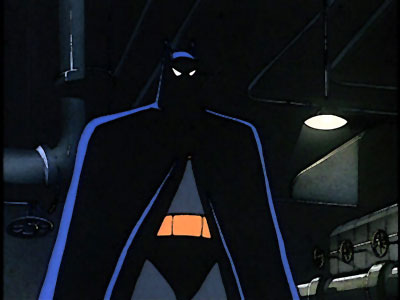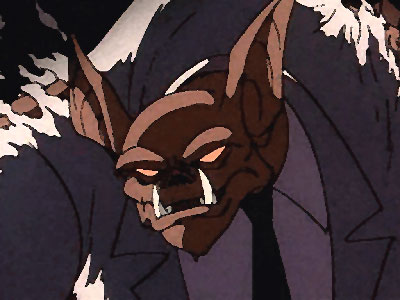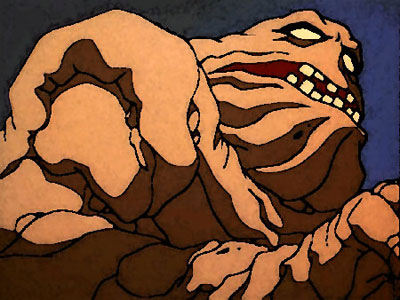He Is the Night, He Is Vengeance, He Is Batman: The Animated Series
Published on September 29th, 2011 in: Cartoons, Comics, Gaming, Halloween, Horror, Movies, TV |By Paul Casey
Batman: The Animated Series was the cause of my love of Batman, superheroes, and later, comic books. I had seen Tim Burton’s wonderful 1989 adaptation early on and went to the cinema to see the underrated and childishly maligned (though rather too scary for my youth) sequel, Batman Returns. I was also aware of the 1960s Adam West TV show.

Even though I enjoyed these, it was the Noir shadows of The Animated Series which got to me. The vision of Bruce Timm, Eric Radomski, Alan Burnett, and Paul Dini would stay with me. The opening is perhaps the most evocative and perfect definition of who Batman is as a character. Danny Elfman’s score is Batman.
Even as a seven-year-old, I detested being spoken down to, and my viewing choices were largely centered around how seriously I expected the program to take its audience, and itself. From the first episode, “On Leather Wings,” written by Mitch Brian, it was clear that while the violence would be restrained, and rampant Bat nudity would be kept to a minimum, this was a smart and mature cartoon. Beginning with a story that examines the fractious relationship between Batman and the law of Gotham, it makes clear the artistic intentions of the show. Gotham has never been more visually sumptuous in an Art Deco style. It is a city out of time; blimps patrol the skies, men still wear hats, and the thugs carry Tommy Guns.
The dynamic between Gordon and Batman is established, as is the lazy and aggressive police work of Detective Bullock and the cowardly politicking of the Mayor. During a discussion on the alleged actions of The Batman—breaking into a pharmaceutical company and throwing a guard out the window—Harvey Dent flips a coin in the corner. Dent is established as the District Attorney in the first episode, and would appear in subsequent episodes as Bruce Wayne’s friend, preparing the viewers for a shock when he transformed in the sublime double episode, “Two-Face.” For a daytime cartoon that did not have the benefit of a James L. Brooks or a Sam Simon behind it, this was clearly an unusually sophisticated and thoughtful show.

“On Leather Wings” is also interesting for how it deals with the supernatural. The fiend responsible for the break-ins, Man-Bat, is a scientist who has gotten a bit too excited about the possibility of splicing himself with a bat. The moment of transformation, when it finally comes, even now seems quite gruesome and frightening. And even though this is a fairly absurd and supernatural villain, the way it is executed never feels inconsistent with the largely realistic depiction of Gotham City. It is the Mad Scientist bag: the deformation and degradation of humanity, a man capable of doing incredible things, but still ultimately a man.
In the episode “Pretty Poison,” things take a similar turn, with the environmentally fixated villain Poison Ivy being written as a real person, not as a creature in the ether who turns and twists reality. Her powers are simply her commitment to her cause and her intelligence at harvesting rare poisons. (Quite close to Batman, then.) Although her character would gradually become more supernatural as time went on, it would be an exception, and as an exception, it would further enforce the key characteristics of both Batman and his world. The episodes “House and Garden” and its follow-up “Chemistry” are both excellent examples of how Batman can work perfectly well with supernatural dangers as long as they never become commonplace.
In “Feat of Clay,” written by Michael Reaves and Marv Wolfman, desperate and deformed actor Matt Hagen is in need of a miracle face cream that allows its users to reshape themselves as they see fit. When he is unable to afford the cost, Hagen runs afoul of gangster Roland Daggett and gets an overdose of the medicine he needs—quite literally—to keep it together.
This turns his entire body into a malleable pile of goo which he soon discovers allows the victim to change into anyone, or anything, he wishes. Visually, Clay-Face is a stunning adversary for Batman. The liquid flow of his movements and the seamless transitions from one form to another show the superlative talent at Warner Bros. Animation in the 1990s. Hagen is a sad man, and one who it’s easy to feel sympathy for when he is taken advantage of by Daggett. Such a sizable challenge also forces Batman (and the writers) to emphasize Batman’s credentials as World’s Greatest Detective. His size and strength enhance, not diminish, Batman’s character. “Feat of Clay” is surely a contender for best episode in the show’s run.

In all three episodes (“On Leather Wings,” “Pretty Poison,” and “Feat of Clay”), each supernatural character retains the right degree of humanity in how they relate to Gotham City and the kinds of challenge they pose for Batman. When incredible things happen they are seen as incredible, not as humdrum, “Oh, another God from another dimension? Where’s the magic crossover ring which allows Batman to fight Gods again?”
Time limit is exhausted. Please reload the CAPTCHA.